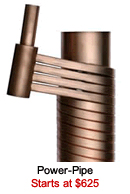
Did you know water heating is the second most costly energy demand in homes, accounting for 20% to 30% of total household energy consumption? Or, that 90% of the energy used to heat water goes down the shower drain? Good news: By installing the Power-Pipe Drain Water Heat Recovery (DWHR) system at home, you can recycle about 60% of the energy that would otherwise be wasted, and reduce your water heating bills by 25% to 40% – and that's without forcing you to alter your lifestyle!
Power-Pipe, a non-storage DWHR unit (e.g., copper heat exchangers made up of two or more copper coils tightly wrapped around an inner copper pipe), works by replacing part of your existing vertical shower drainage pipe. As you take a shower, the heat from the outgoing drain water clings to the inner copper pipe wall and transfers its heat to the incoming cold, freshwater in the outer copper coils (i.e., “pre-heating” the water supply for the water heater).
Since copper is an excellent conductor of heat, the effects are dramatic. In a typical home, the DWHR unit can easily raise the cold water temperature from 50° F to 77° F (10° C to 25° C) – thus saving you energy, time and money.
Other highlights of the Power-Pipe includes:
- Easy to install or retrofit in almost any home by most “Do-It-Yourselfers” or plumbers
- May be used with tank, tankless, or solar water heaters
- Prevents hot water from running out
- Causes no noticeable water pressure loss
- Provides perfectly save to drink water
- Requires no maintenance, and comes with 10-year warranty
- Performance verified by Canadian government
- May be used to harness the energy from cold to “pre-cool” water or other liquids in industrial, commercial, or institutional settings
PowerPipe material and installation costs may vary depending on the size and length you need (between $625 and $995). Given the return on investment is 15% to 50% per year (i.e., 2- to 5-year payback period), however, that is a relatively small investment for 20+ years of savings.
